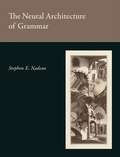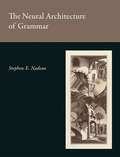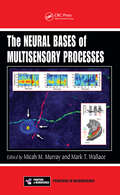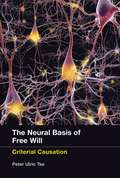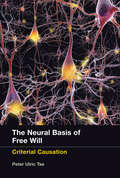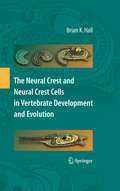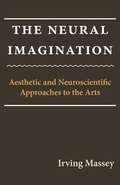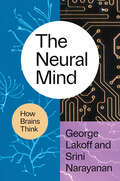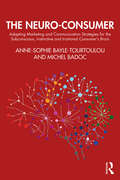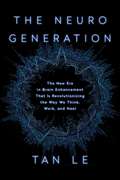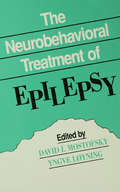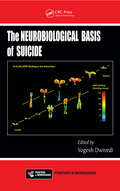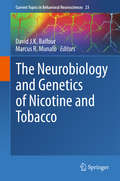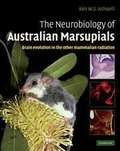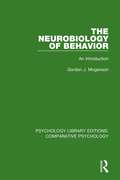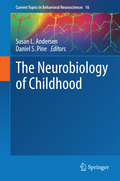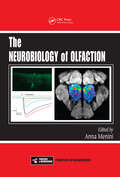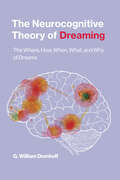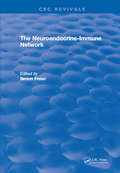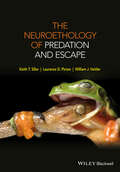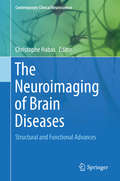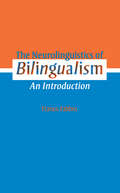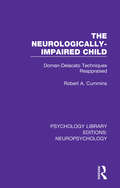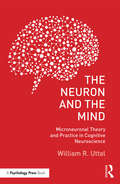- Table View
- List View
The Neural Architecture of Grammar
by Stephen E. NadeauLinguists have mapped the topography of language behavior in many languages in intricate detail. To understand how the brain supports language function, however, we must take into account the principles and regularities of neural function. Mechanisms of neurolinguistic function cannot be inferred solely from observations of normal and impaired language. In The Neural Architecture of Grammar, Stephen Nadeau develops a neurologically plausible theory of grammatic function. He brings together principles of neuroanatomy, neurophysiology, and parallel distributed processing and draws on literature on language function from cognitive psychology, cognitive neuropsychology, psycholinguistics, and functional imaging to develop a comprehensive neurally based theory of language function. Nadeau reviews the aphasia literature, including cross-linguistic aphasia research, to test the model's ability to account for the findings of these empirical studies. Nadeau finds that the model readily accounts for a crucial finding in cross-linguistic studies--that the most powerful determinant of patterns of language breakdown in aphasia is the predisorder language spoken by the subject--and that it does so by conceptualizing grammatic function in terms of the statistical regularities of particular languages that are encoded in network connectivity. He shows that the model provides a surprisingly good account for many findings and offers solutions for a number of controversial problems. Moreover, aphasia studies provide the basis for elaborating the model in interesting and important ways.
The Neural Architecture of Grammar (The\mit Press Ser.)
by Stephen E. NadeauA comprehensive, neurally based theory of language function that draws on principles of neuroanatomy, cognitive psychology, cognitive neuropsychology, psycholinguistics, and parallel distributed processing.Linguists have mapped the topography of language behavior in many languages in intricate detail. To understand how the brain supports language function, however, we must take into account the principles and regularities of neural function. Mechanisms of neurolinguistic function cannot be inferred solely from observations of normal and impaired language. In The Neural Architecture of Grammar, Stephen Nadeau develops a neurologically plausible theory of grammatic function. He brings together principles of neuroanatomy, neurophysiology, and parallel distributed processing and draws on literature on language function from cognitive psychology, cognitive neuropsychology, psycholinguistics, and functional imaging to develop a comprehensive neurally based theory of language function. Nadeau reviews the aphasia literature, including cross-linguistic aphasia research, to test the model's ability to account for the findings of these empirical studies. Nadeau finds that the model readily accounts for a crucial finding in cross-linguistic studies—that the most powerful determinant of patterns of language breakdown in aphasia is the predisorder language spoken by the subject—and that it does so by conceptualizing grammatic function in terms of the statistical regularities of particular languages that are encoded in network connectivity. He shows that the model provides a surprisingly good account for many findings and offers solutions for a number of controversial problems. Moreover, aphasia studies provide the basis for elaborating the model in interesting and important ways.
The Neural Bases of Multisensory Processes (Frontiers in Neuroscience)
by Mark T. Wallace Micah M. MurrayIt has become accepted in the neuroscience community that perception and performance are quintessentially multisensory by nature. Using the full palette of modern brain imaging and neuroscience methods, The Neural Bases of Multisensory Processes details current understanding in the neural bases for these phenomena as studied across species, stages
The Neural Basis of Free Will
by Peter Ulric TseThe issues of mental causation, consciousness, and free will have vexed philosophers since Plato. In this book, Peter Tse examines these unresolved issues from a neuroscientific perspective. In contrast with philosophers who use logic rather than data to argue whether mental causation or consciousness can exist given unproven first assumptions, Tse proposes that we instead listen to what neurons have to say. Because the brain must already embody a solution to the mind--body problem, why not focus on how the brain actually realizes mental causation? Tse draws on exciting recent neuroscientific data concerning how informational causation is realized in physical causation at the level of NMDA receptors, synapses, dendrites, neurons, and neuronal circuits. He argues that a particular kind of strong free will and "downward" mental causation are realized in rapid synaptic plasticity. Recent neurophysiological breakthroughs reveal that neurons function as criterial assessors of their inputs, which then change the criteria that will make other neurons fire in the future. Such informational causation cannot change the physical basis of information realized in the present, but it can change the physical basis of information that may be realized in the immediate future. This gets around the standard argument against free will centered on the impossibility of self-causation. Tse explores the ways that mental causation and qualia might be realized in this kind of neuronal and associated information-processing architecture, and considers the psychological and philosophical implications of having such an architecture realized in our brains.
The Neural Basis of Free Will: Criterial Causation
by Peter Ulric TseA neuroscientific perspective on the mind–body problem that focuses on how the brain actually accomplishes mental causation. The issues of mental causation, consciousness, and free will have vexed philosophers since Plato. In this book, Peter Tse examines these unresolved issues from a neuroscientific perspective. In contrast with philosophers who use logic rather than data to argue whether mental causation or consciousness can exist given unproven first assumptions, Tse proposes that we instead listen to what neurons have to say. Tse draws on exciting recent neuroscientific data concerning how informational causation is realized in physical causation at the level of NMDA receptors, synapses, dendrites, neurons, and neuronal circuits. He argues that a particular kind of strong free will and “downward” mental causation are realized in rapid synaptic plasticity. Such informational causation cannot change the physical basis of information realized in the present, but it can change the physical basis of information that may be realized in the immediate future. This gets around the standard argument against free will centered on the impossibility of self-causation. Tse explores the ways that mental causation and qualia might be realized in this kind of neuronal and associated information-processing architecture, and considers the psychological and philosophical implications of having such an architecture realized in our brains.
The Neural Code of Pitch and Harmony
by Langner, Gerald and Benson, Christina Gerald Langner Christina BensonHarmony is an integral part of our auditory environment. Resonances characterised by harmonic frequency relationships are found throughout the natural world and harmonic sounds are essential elements of speech, communication and, of course, music. Providing neurophysiological data and theories that are suitable to explain the neural code of pitch and harmony, the author demonstrates that musical pitch is a temporal phenomenon and musical harmony is a mathematical necessity based on neuronal mechanisms. Moreover, he offers new evidence for the role of an auditory time constant for speech and music perception as well as for similar neuronal processing mechanisms of auditory and brain waves. Successfully relating current neurophysiological results to the ancient ideas of Pythagoras, this unique title will appeal to specialists in the fields of neurophysiology, neuroacoustics, linguistics, behavioural biology and musicology as well as to a broader audience interested in the neural basis of music perception.
The Neural Crest and Neural Crest Cells in Vertebrate Development and Evolution
by Brian K. HallA presentation of all aspects of neural crest cell origins (embryological and evolutionary) development and evolution; neural crest cell behavior (migration) and anomalies (neurocristopathies and birth defects) that arise from defective neural crest development. The treatment of development will include discussions of cellular, molecular and genetic aspects of the differentiation and morphogenesis of neural crest cells and structures derived from neural crest cells. The origins of the neural crest in embryology will be discussed using the recent information on the molecular basis of the specification of the neural crest. Also presented are the advances in our understanding of the evolution of jaws from studies on lampreys and of the neural crest from studies on ascidians and amphioxus.
The Neural Imagination
by Irving MasseyArt and technology have been converging rapidly in the past few years; an important example of this convergence is the alliance of neuroscience with aesthetics, which has produced the new field of neuroaesthetics. Irving Massey examines this alliance, in large part to allay the fears of artists and audiences alike that brain science may "explain away" the arts. The first part of the book shows how neuroscience can enhance our understanding of certain features of art. The second part of the book illustrates a humanistic approach to the arts; it is written entirely without recourse to neuroscience, in order to show the differences in methodology between the two approaches. The humanistic style is marked particularly by immersion in the individual work and by evaluation, rather than by detachment in the search for generalizations. In the final section Massey argues that, despite these differences, once the reality of imagination is accepted neuroscience can be seen as the collaborator, not the inquisitor, of the arts.
The Neural Mind: How Brains Think
by George Lakoff Srini NarayananOffers an expansive, unified theory of thought that brings together the vast resources of neuroscience, computation, and cognitive linguistics. What is an idea, and where does it come from? We experience thought as if it were abstract, but every thought is actually a physical thing, carried out by the neural systems of our brains. Thought does not occur neuron-by-neuron; it happens when neurons come together to form circuits and when simple circuits combine to form complex ones. Thoughts, then, derive their structures from the circuitry we also use for vision, touch, and hearing. This circuitry is what allows simple thoughts to come together into complex concepts, making meaning, creating metaphors, and framing our social and political ideas. With The Neural Mind, George Lakoff, a pioneering cognitive linguist, and computer scientist Srini Narayanan deftly combine insights from cognitive science, computational modeling, and linguistics to show how thoughts arise from the neural circuitry that runs throughout our bodies. They answer key questions about the ways we make meaning: How does neural circuitry create the conceptual “frames” through which we understand our social lives? What kind of neural circuitry characterizes metaphorical thought, in which ideas are understood in terms of other ideas with similar structures? Lively and accessible, the book shows convincingly that the “metaphors we live by”—to use Lakoff’s famous phrase—aren’t abstractions but deeply embodied neural constructs. The Neural Mind is the first book of its kind, bringing together the ideas of multiple disciplines to offer a unified, accessible theory of thought. A field-defining work, Lakoff and Narayanan’s book will be of interest not just to linguists and cognitive scientists but also to psychologists, philosophers, anthropologists, journalists, sociologists, and political scientists—and anyone who wants to understand how we really think.
The Neuro-Consumer: Adapting Marketing and Communication Strategies for the Subconscious, Instinctive and Irrational Consumer's Brain
by Michel Badoc Anne-Sophie Bayle-TourtoulouNeuroscientific research shows that the great majority of purchase decisions are irrational and driven by subconscious mechanisms in our brains. This is hugely disruptive to the rational, logical arguments of traditional communication and marketing practices and we are just starting to understand how organizations must adapt their strategies. This book explains the subconscious behavior of the "neuro-consumer" and shows how major international companies are using these findings to cast light on their own consumers’ behavior. Written in plain English for business and management readers with no scientific background, it focuses on: how to adapt marketing and communication to the subconscious and irrational behaviors of consumers; the direct influence of the primary senses (sight, hearing, smell, taste, touch) on purchasing decisions and the perception of communications by customers’ brains; implications for innovation, packaging, price, retail environments and advertising; the use of "nudges" and artifices to increase marketing and communication efficiency by making them neuro-compatible with the brain’s subconscious expectations; the influence of social media and communities on consumers’ decisions – when collective conscience is gradually replacing individual conscience and recommendation becomes more important than communication; and the ethical limits and considerations that organizations must heed when following these principles. Authored by two globally recognized leaders in business and neuroscience, this book is an essential companion to marketers and brand strategists interested in neuroscience and vital reading for any advanced student or researcher in this area.
The NeuroGeneration: The New Era in Brain Enhancement That Is Revolutionizing the Way We Think, Work, and Heal
by Tan LeBrain science is at the dawn of a new era—and the technologies emerging as a result could forever alter what it means to be human. Welcome to what tech pioneer and inventor Tan Le calls "the NeuroGeneration." It will blow your mind. The human brain is perhaps the most powerful and mysterious arrangement of matter in the known universe. New discoveries that unravel this mystery and let us tap into this power offer almost limitless potential—the ability to reshape ourselves and our thought processes, to improve our health and extend our lives, and to enhance and augment the ways we interact with the world around us. It may sound like the stuff of science fiction, but it is quickly becoming reality. In The NeuroGeneration, award-winning inventor Tan Le explores exciting advancements in brain science and neurotechnology that are revolutionizing the way we think, work, and heal. Join Le as she criss-crosses the globe, introducing the brilliant neurotech innovators and neuroscientists at the frontiers of brain enhancement. Along the way, she shares incredible stories from individuals whose lives are already being transformed by their inventions—an endurance racer paralyzed in a fall, who now walks thanks to neural stimulation and an exoskeleton; a man who drives a race car with his mind; even a color-blind "cyborg" whose brain implant allows him to "hear" colors. The NeuroGeneration reveals the dizzying array of emerging technologies—including cranial stimulation that makes you learn faster, an artificial hippocampus that restores lost memories, and neural implants that aim to help us keep up with or even outpace artificial intelligence—that promise to alter the brain in unprecedented ways, unlocking human potential we never dreamed possible. Le also explores how these futuristic innovations will impact our world, disrupt the way we do business, upend healthcare as we know it, and remake our lives in wondrous and unexpected ways. As fascinating as it is timely, The NeuroGeneration offers a thrilling glimpse of the future of our species, and how changing our brains can change human life as we know it.
The Neurobehavioral Treatment of Epilepsy
by David I. Mostofsky Yngve LøyningThis volume is a first of its kind, addressed principally to the professional reader. While it is not intended to be exhaustive, its aim is to sketch a broad picture of some of the nondrug and nonsurgical treatment strategies with a demonstrated basis in conventional scientific method. Likewise, though it does not include all those who have contributed to the emergence of this exciting new field, it assembles those authors whose seminal work has earned them international reputations. This volume's declared purpose is to provide a state-of-the-art guide to methods and techniques in the behavioral treatment of epilepsy and to their basis in theory. The editors hope that it will catalyze the evolution of their acceptance as standard elements, where appropriate, in the clinical activities of independent practitioners, clinics, and agencies that service those with convulsive disorders.
The Neurobiological Basis of Suicide
by Yogesh DwivediWith recent studies using genetic, epigenetic, and other molecular and neurochemical approaches, a new era has begun in understanding pathophysiology of suicide. Emerging evidence suggests that neurobiological factors are not only critical in providing potential risk factors but also provide a promising approach to develop more effective treatment
The Neurobiology and Genetics of Nicotine and Tobacco
by Marcus R. Munafò David J. K. BalfourThe primary purpose of this book and its companion volume The Neuropharmacology of Nicotine Dependence is to explore the ways in which recent studies on nicotine and its role in tobacco addiction have opened our eyes to the psychopharmacological properties of this unique and fascinating drug. While the present volume considers the molecular and genetic factors which influence behavioral responses to nicotine and how these may impact on the role of nicotine in tobacco dependence, the book The Neuropharmacology of Nicotine Dependence focuses on the complex neural and psychological mechanisms that mediate nicotine dependence in experimental animal models and their relationship to tobacco addiction in humans. These volumes will provide readers with a contemporary overview of current research on nicotine psychopharmacology and its role in tobacco dependence from leaders in this field of research and will hopefully prove valuable to those who are developing their own research programmes in this important topic.
The Neurobiology of Australian Marsupials
by Ken W. S. AshwellAustralian marsupials represent a parallel adaptive radiation to that seen among placental mammals. This great natural experiment has produced a striking array of mammals with structural and behavioural features echoing those seen among primates, rodents, carnivores, edentates and ungulates elsewhere in the world. Many of these adaptations involve profound evolutionary changes in the nervous system, and occurred in isolation from those unfolding among placental mammals. Ashwell provides the first comprehensive review of the scientific literature on the structure and function of the nervous system of Australian marsupials. The book also includes the first comprehensive delineated atlases of brain structure in a representative diprotodont marsupial (the tammar wallaby) and a representative polyprotodont marsupial (the stripe-faced dunnart). For those interested in brain development, the book also provides the first comprehensive delineated atlas of brain development in a diprotodont marsupial (the tammar wallaby) during the critical first 4 weeks of pouch life.
The Neurobiology of Behavior: An Introduction (Psychology Library Editions: Comparative Psychology)
by Gordon J. MogensonOriginally published in 1977, the objective of this book was to examine the mechanisms by which the multiple factors or determinants – homeostatic deficits, hormonal influences, circadian rhythms, experiential and cognitive factors – become translated by the central nervous system into thermoregulatory, feeding, sexual, aggressive, and other behaviours. A conceptual framework has been used that reflects relevant contributions from biology, regulatory physiology, physiological psychology, and other neuroscience disciplines. The final chapter deals with difficulties in brain-behaviour research in relation to experimental strategies and with crucial problems for future investigation.
The Neurobiology of Childhood (Current Topics in Behavioral Neurosciences #16)
by Susan L. Andersen and Daniel S. PineDuring the past years there has been rapid progress in the understanding of how early life stress impacts psychopathology in children. The first two parts of this book present the basic principles of brain development and describe the most important neuronal systems. This includes systems involved in emotion processing, cognitive control, and social processes. These first two general sections are followed by an overview about recent research on various neuronal and psychiatric disorders, where environmental exposures and altered brain development play an important role: sleep, autism, ADHD and other developmental forms of psychopathology.
The Neurobiology of Olfaction (Frontiers in Neuroscience)
by Anna MeniniComprehensive Overview of Advances in OlfactionThe common belief is that human smell perception is much reduced compared with other mammals, so that whatever abilities are uncovered and investigated in animal research would have little significance for humans. However, new evidence from a variety of sources indicates this traditional view is likely
The Neurocognitive Theory of Dreaming: The Where, How, When, What, and Why of Dreams
by G. William DomhoffA comprehensive neurocognitive theory of dreaming based on the theories, methodologies, and findings of cognitive neuroscience and the psychological sciences.G. William Domhoff&’s neurocognitive theory of dreaming is the only theory of dreaming that makes full use of the new neuroimaging findings on all forms of spontaneous thought and shows how well they explain the results of rigorous quantitative studies of dream content. Domhoff identifies five separate issues—neural substrates, cognitive processes, the psychological meaning of dream content, evolutionarily adaptive functions, and historically invented cultural uses—and then explores how they are intertwined. He also discusses the degree to which there is symbolism in dreams, the development of dreaming in children, and the relative frequency of emotions in the dreams of children and adults. During dreaming, the neural substrates that support waking sensory input, task-oriented thinking, and movement are relatively deactivated. Domhoff presents the conditions that have to be fulfilled before dreaming can occur spontaneously. He describes the specific cognitive processes supported by the neural substrate of dreaming and then looks at dream reports of research participants. The &“why&” of dreaming, he says, may be the most counterintuitive outcome of empirical dream research. Though the question is usually framed in terms of adaptation, there is no positive evidence for an adaptive theory of dreaming. Research by anthropologists, historians, and comparative religion scholars, however, suggests that dreaming has psychological and cultural uses, with the most important of these found in religious ceremonies and healing practices. Finally, he offers suggestions for how future dream studies might take advantage of new technologies, including smart phones.
The Neuroendocrine Immune Network
by S. FreierThis informative publication updates the study of interaction of the nervous and endocrine systems with the immune system in the body. It describes the anatomical basis of these interactions, reviewing the innervation of lymphoid tissue and mast cells. The book discusses the effect of the endocrine system on immune function, including the relation of sex to the immune response. Emphasis is given to opioids, substance P, neurotensin, vasoactive intestinal peptide, somatostatin and cholecystokinin. Also addressed is the immunoregulatory effect of leukotrienes and platelet-activating factors. Scrutinized within are stress as an aspect of neuro-immune interactions, and the central role of the hypothalamus in this context. The book reviews the eye and the gastrointestinal tract with respect to the coordination of the nervous, endocrine, and immune systems in serving these organs. This work is of particular value to those in immunology, endocrinology, gastroenterology, and developmental biology.
The Neuroethology of Predation and Escape
by Keith T. Sillar William J. Heitler Laurence D. PictonThe forces of natural selection have been a primary driver in the evolution of adaptive animal behaviours. On the one hand animals must evade predation in order to survive and pass on their genes; on other hand, and for the same underlying reasons, animals must also be capable of successfully capturing prey. This situation has led to an evolutionary arms race in which predator and prey are locked in the battle to survive. A common strategy in each situation is to enhance the speed of response, resulting in the evolution of neural, muscular and biomechanical designs that produce supremely fast and eye-catching behavioral responses. The aim of this book is to illuminate the design principles of escape and predatory behaviours using a series of case histories from different animal groups and to emphasize the convergent evolution of neural circuitry that optimizes the chances of survival. Using these case histories the authors describe sensory mechanisms that aid prey and predator detection, central neural circuit designs that increase speed of response and neuromuscular and biomechanical properties that aid the performance of escape and predatory movements.
The Neuroimaging of Brain Diseases: Structural and Functional Advances (Contemporary Clinical Neuroscience)
by Christophe HabasNotable experts in the field of neuroimaging provide comprehensive overviews of advances in functional and structural aspects of both common and uncommon brain disorders. Functional imaging is evolving quickly but researchers and clinicians do not always have a strong understanding of the fundamental basis of the imaging techniques that they use. By focusing on both structure and function this book will provide a strong foundation for emerging developments in the field.
The Neurolinguistics of Bilingualism: An Introduction
by Franco FabbroThis book introduces the reader to both neurolinguistics per se and the neuropsychological aspects of bilingualism. Neurolinguistics may roughly be defined as a subset of neuropsychology, namely the study of the representation and processing of language in the brain. To this effect, the first chapters of the book focus on the basic neuropsychology of language processing and acquisition. The second half of the book addresses the issues of cerebral representation and processing of language in bi-or multilingual subjects. All aspects are systematically dealt with, namely the definition of bilingualism; an analysis of all the issues related to bilingual aphasia, i.e. patterns of recovery of the patients' carious languages in diverse population; an investigation of the methodologies used in the study of the neuropsychological aspects of the various linguistic functions, such as comprehension, production and translation; and lastly, the issues of cerebral lateralization and neuroanatomical localization of the numerous cortical and subcortical structures subserving the various language system components in multilingual subjects. It is an excellent introduction to both the neuropsychology of language and the phenomena related to bilingualism. This book will be of particular interest to students of language therapy, aphasiology, applied psycholinguistics, neurolinguistics and, in general, to students of medicine who wish to become more knowledgeable about the specific needs of patients in a multilingual society.
The Neurologically-Impaired Child: Doman-Delacato Techniques Reappraised (Psychology Library Editions: Neuropsychology #4)
by Robert A. CumminsFor the 25 years before publication a form of therapy known as the ‘Doman-Delacato Techniques’ had been applied to children with disabilities. The therapy originated from the work of Glen Doman and Carl Delacato who established the Institutes for the Achievement of Human Potential in Philadelphia. The institutes claim to be able to treat a wide range of disabilities, and their best known technique is called ‘Patterning’ and is prescribed for children who have no capacity for voluntary movement. Yet many professional bodies and associations have denounced the approach as overly-expensive, ineffective, creating false hopes, being destructive to family life and based on false theoretical assumptions. Originally published in 1988, this book was the first to offer a detailed analysis and critique of the Doman-Delacato approach. The author draws on data from evolution, neuroanatomy and neurophysiology to challenge its theoretical assumptions. He shows that there is no sound scientific basis to the techniques. Any improvements in a child's condition can be attributed to the increased energy and attention given to that child, rather than the content of the programme. At the same time parents become emotionally ransomed and deluded by false expectations. Written in a style that will be accessible to non-specialists, the book is an important work for both parents and professionals concerned with the welfare of neurologically-impaired children.
The Neuron and the Mind: Microneuronal Theory and Practice in Cognitive Neuroscience
by William R. UttalThis book, a companion to William R. Uttal’s earlier work on macrotheories theories of mind-brain relationships, reviews another set of theories—those based on microneuronal measurements. Microneural theories maintain the integrity of individual neurons either in isolation or as participants in the great neuronal networks that make up the physical brain. Despite an almost universal acceptance by cognitive neuroscientists that the intangible mind must, in some way, be encoded by network states, Uttal shows that the problem of how the transformation occurs is not yet supported by empirical research findings at the micro as well as at the macro levels of analysis. Theories of the neuronal network survive more as metaphors than as robust explanations. This book also places special emphasis on the technological developments that stimulate these metaphors. A major conclusion drawn in this book is that it is not at all certain that the mind-brain problem is solvable in the sense that many other grand scientific problems are.
